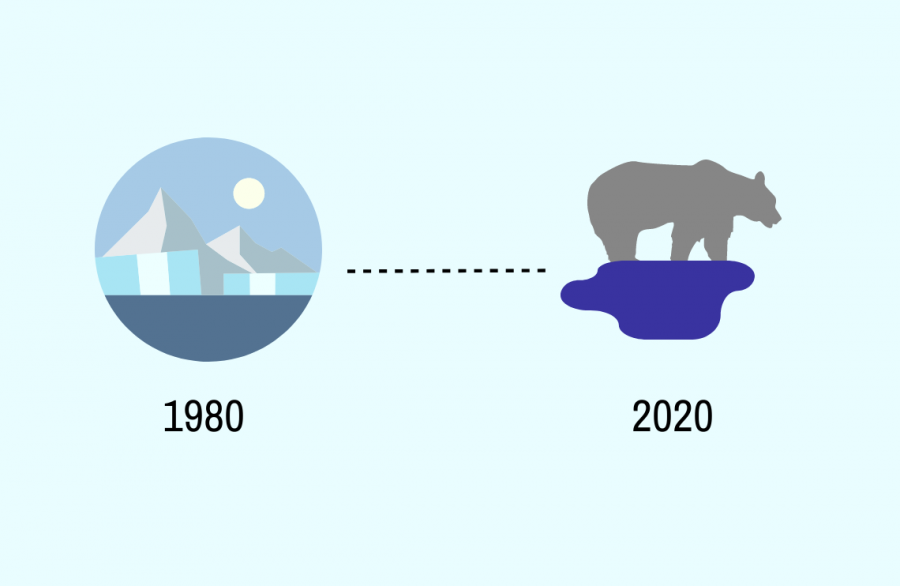#SaveTheArctic: Over the years
Throughout the history of climate activism, the public has never had as powerful of an influence as they do today. WSS staffer Alaina Greenlee ’23 explains the history of the Save the Arctic movement and why now is the time to take action.
From 1980-2020, sea ice in the Arctic has decreased from 16.25 million square kilometers to 3.74 million square kilometers.
The world couldn’t have turned into what it is today without protests or pushback from the people. From the civil rights movements in the early 1900s all the way up to today’s Black Lives Matter and climate movements, US citizens have been fighting for not only a better society but a better world. The official Save the Arctic movement has been around for nearly a decade, but hasn’t always been so popular.
This movement has been trying to prevent gas and oil development in the Arctic National Wildlife Refuge, preserving sacred indigenous land and one of the last untouched ecosystems. This 19.4 million-acre refuge is the last five percent of the Alaskan northern coast that hasn’t been affected by energy development. Drilling in the Wildlife Refuge would have catastrophic impacts on climate change and human rights. Ice and permafrost would melt, quickening the rate the Arctic is currently warming at from over twice the global rate, the Gwich’in and Iñupiat people would lose their way of life, and several species like caribou and polar bears would be at risk. According to Greenpeace, the founding organization, Save the Arctic has amassed a following of over 70% of the American population. Its first successful protests were in 2012, but the movement consistently fails to be covered in the mainstream media.
During the first month of founding, over one million people teamed up with Greenpeace to defend the Arctic, crushing the initial goal of one million signatures within a year. Since then, nearly nine million additional signatures haven’t quite reached the ultimate goal of ten million. With such a powerful start, it seems like the movement should have gained more traction.
Inconsistent coverage has dealt critical blows to the movement. Though smaller news outlets or social media creators may have been creating content to raise awareness, most power laid with large news organizations. Save the Arctic blew up in early December, but up until then, large-scale coverage was patchy. One key event covered was the fight against one of the most powerful oil companies in the world. In 2017, Shell attempted to drill in the Arctic, blowing up the People vs. Shell movement. Ardent supporters jamming up bridges and routes of the oil icebreaker eventually swayed the Obama administration to pause Arctic drilling for two years. Today, Save the Arctic is a new version of People vs. Shell that won’t stop pushing until permanent protection of the Arctic is achieved.
Despite signs of global warming in addition to a global cooling scare from 1940-1970, climate activism didn’t truly become popular until the 1990s. After large organizations like the United Nations Framework Convention on Climate Change formed and spoke out about climate change, the public followed. Starting with small climate action such as Earth First! protests in the 1980s, climate activism eventually grew in popularity, leading to today’s largest climate protest, sparked by a teenager.
With this increasing momentum, supporters have high hopes for the Save the Arctic movement. In order to bring more awareness to the cause, supporters have turned to social media. On TikTok alone, only four of the hundreds of Save the Arctic hashtags total well over 42 million views. These videos encourage signing petitions and sending letters to the Fish and Wildlife Service to attempt to sway the decision of moving forward with exploration. The Protect the Arctic petition collected over 6.3 million letters and contributed to Biden’s executive order to pause oil and gas development in the Wildlife Refuge on Jan. 6, 2021. New letters to President Biden can be sent through Greenpeace or Protect the Arctic by using a completed default message or writing your own.
Now, supporters are pushing for permanent protection, starting with New Mexico Senator Deb Haaland becoming the Interior Secretary. A new part of the campaign is pushing citizens to write to their state representatives, requesting that avid climate activist Senator Haaland be the new Secretary of the Interior. Senator Haaland has been known to fight for the protection of public land, human rights, and climate change, providing a huge step forward for the movement.
Save the Arctic can only become as popular as news outlets, and most importantly the people, allow it to. The passion within these supporters has driven the movement beyond expectations in two months. Oil drilling and fracking aren’t going away overnightーit’s this passion that is going to be needed in the long battle for the protection of the Arctic, and our world.
Your donation will support the student journalists of West High School. Your contribution will allow us to purchase Scholarship Yearbooks, newsroom equipment and cover our annual website hosting costs.

(she/her) Alaina Greenlee is a senior at West and is in her second year as the WSS Video Editor. Between creating half-decent videos and being below average...

Emma Hall is a senior at West and this is her third year on staff as an artist for online staff. in her free time she likes to draw, read, and play video...



